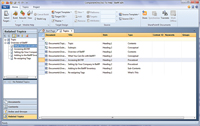Product Reviews
Doc-To-Help 2012 Adds HTML5-Based Mobile Help
Doc-To-Help continues to provide a single source for a variety of document and help types, including a jQuery format targeted for mobile devices.
ComponentOne Doc-To-Help allows developers to leverage their knowledge of Microsoft Word (see Figure 1) to create a wide range of documentation, including user guides, all of the Microsoft Help formats and a variety of HTML-based formats.

[Click on image for larger view.] |
| Figure 1. The Doc-To-Help project management environment incorporates UI components familiar to users of Microsoft Word, Outlook and Visual Studio. |
The Doc-To-Help support for Microsoft-based Help formats is exemplary. Creating Help topics, glossary terms, index terms and related topic items just requires selecting the text and right-clicking on the Doc-To-Help toolbar (when generating HTML-based help, Doc-To-Help converts these into hyperlinks between pages). Topics can easily be assigned context IDs (to support context-based Help in Windows applications) and keywords. To support creating printed documents, Web pages and Help files, the Doc-To-Help project manager switches quickly between a topics-based view and a table-of-contents view.
The main issue with Doc-To-Help is, unlike some other single-source tools, it doesn't use proprietary input formats. If you create your documents in Microsoft Word while targeting one of the browser-based formats as your output, Doc-To-Help has to perform some translation to get from Word to HTML. While Doc-To-Help specializes in making these conversions, taking full advantage of all the features in Word might result in less-than-optimal output. I haven't been surprised by these translations in several years, however, reflecting the increasing sophistication of Doc-To-Help.
New Mobile Format
Doc-To-Help has been around for 20 years, so there's not much left to add to the package. What Doc-To-Help 2012 does add, however, targets some key scenarios. If you're producing browser-based HTML Help using the NetHelp 2.0 format, your resulting files will automatically satisfy many of the requirements for Section 508 compliance. The Doc-To-Help NetHelp 2.0 formats incorporate jQuery to automate client-side interaction, but Doc-To-Help 2012 adds a new format called Mobile Help that uses jQuery Mobile to give a similar experience on mobile devices. And, with Doc-To-Help 2012, provided you have Windows Identity Foundation installed and a recent version of Windows, you can integrate your output with SharePoint Online (part of Office 365).
The Enterprise version of Doc-To-Help 2012 adds support for multiple authors, and the ability to author in HTML and import from other Help file formats. The Enterprise version supports integration with SharePoint (including the ability to upload a project's components to a SharePoint translation library) and Visual Studio Team Foundation Server.
The key issue to consider when you evaluate Doc-To-Help is whether it's more of a document-generation solution than you require. If all you need is Windows-, print- or HTML-based documentation, a targeted tool might be a better choice for you. However, if you intend to target multiple environments (for instance, making your manual for policy and procedures available as both a printed document and an HTML site), Doc-To-Help is an excellent choice.
ComponentOne LLC
Web: doctohelp.com
Phone: 800-858-2739
Price: $745 without support, $1,045 with support; Enterprise pricing starts at $1,095
Quick Facts: A Microsoft Word-based tool for creating manuals, Microsoft Help files and HTML pages from a single source
Pros: Leverages your existing knowledge of Microsoft Help to generate output in any of the supported formats
Cons: Might be more tool than you need.
About the Author
Peter Vogel is a system architect and principal in PH&V Information Services. PH&V provides full-stack consulting from UX design through object modeling to database design. Peter tweets about his VSM columns with the hashtag #vogelarticles. His blog posts on user experience design can be found at http://blog.learningtree.com/tag/ui/.